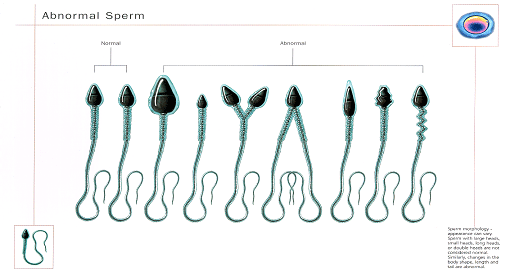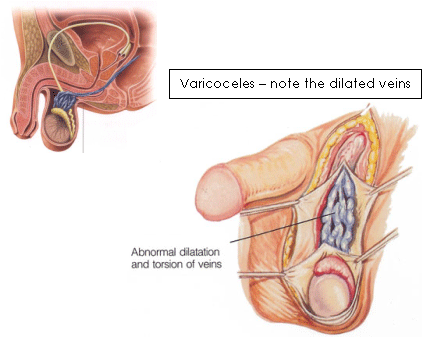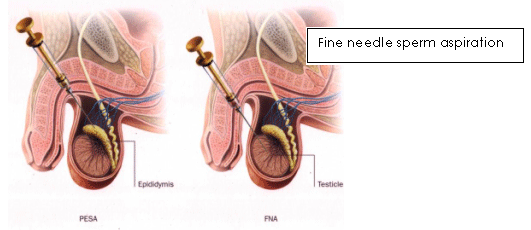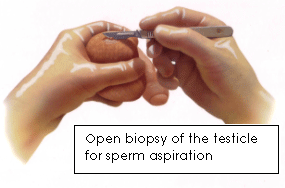Male Infertility
About 15-20% of couples do not achieve a pregnancy within 12 months of trying to have a child. The man may have a disorder which accounts or contributes to the low fertility in up to 50% of these couples. Thus medical investigation of infertility should, from the outset, involve both the man and the woman. Potential male factors are described throughout page. Whatever the cause, coping with infertility is never easy. Many men feel robbed of their virility when they discover a fertility problem, and some struggle with feelings of poor self-esteem. These responses are normal. The key to overcoming them is mutual support within a primary relationship. Whether difficulty conceiving is related to male factors, female factors, or both, infertility is a couple’s shared challenge.
The results of the examination and tests help the doctor determine whether or not a treatable condition exists. At Concept, approximately 13% of men have untreatable sterility, 11% have treatable conditions and 76% have disorders of sperm production or function which do not usually have clearly defined effective treatments.
Of the 13% of men with untreatable sterility, most have no sperm in their semen (azoospermia) because the tubules in the testes which produce sperm did not develop or have been irreversibly damaged. This may be associated with failure of the testes to descend into the scrotum during childhood, inflammation of the testes or treatment with certain drugs. In some sterile men, sperm are produced in normal numbers, but they are either not motile (do not swim) or lack structures necessary for penetration and fertilisation of eggs which may be detected by microscope examination of the shape of the sperm and reported as abnormal morphology. Some men with failure of sperm production do not produce normal amounts of the male sex hormone testosterone and their general health and sexual performance is improved by treatment with testosterone. The possibilities for couples in this category to have a family include ICSI (with or without testicular/epididymal aspiration of sperm, use of donor sperm or adoption.)
Sperm are produced by repeated division of cells in small coiled tubules within the testes at a rate of appropriately 100 million per day. Sperm production is a lengthy process; from the beginning of division of the stem cell to the appearance of mature sperm in the semen takes about 3 months. The sperm spend 2 to 10 days passing through the epididymis, during which time they mature and become capable of swimming and fertilising eggs. The volume of liquid from the testes and epididymides is less than 5% of the total semen volume. About 65% of the semen volume comes from the seminal vesicles and 25% from the prostate gland. The average semen volume for healthy men ejaculating every two days is 3 ml and the sperm concentration, 85 million per ml. During ejaculation the sperm and the prostatic fluid come out first and the seminal vesicle fluid follows. The seminal vesicle fluid coagulates giving the semen a lumpy gel-like appearance. After 10 minutes or so liquefaction occurs and the gel disappears.
Under usual conditions with sexual intercourse during the fertile phase of the woman's menstrual cycle sperm quickly enter the cervical mucus and ascend the uterus and Fallopian tubes to the site of fertilisation in the outer third of the tube. Sperm require motility (swimming ability) to get into cervical mucus and to penetrate the outer coverings of the ovum.
The function of the testes is dependent upon hormones from the pituitary gland - follicle stimulating hormone (FSH) and luteinizing hormone (LH). The level of these hormones rise during the early stages of puberty and stimulates testicular development. LH controls production of the male sex hormone testosterone which in turn is responsible for development of the genitals, beard and body hair, prostate and seminal vesicles, and also bone and muscle development and other aspects of masculine physique. If LH and FSH are deficient the testes do not develop properly. In contrast, if the testes are damaged directly, the levels of these hormones in the blood rise. Thus the measurement of LH, FSH and testosterone in blood helps in the diagnosis of testicular disorders.
Factors that Influence Fertility
A man’s overall health can have a significant impact on his fertility. When you are trying to conceive, it is important to maintain a healthy lifestyle. These are some issues to consider.
Behavioral factors
Personal habits such as nutrition, exercise, smoking, or drug and alcohol intake can influence overall health and perhaps fertility. Discuss your habits with your doctor. Many of these factors can be controlled to improve the likelihood of conception.
Medications
A number of medications, including some common medications used to treat ulcers and high blood pressure, can influence a man’s sperm count and libido (sex drive). Discuss the effects of all prescription and over-the-counter medications with your doctor.
Drugs
Drugs such as marijuana, anabolic steroids, and cocaine may affect sperm counts. The effects of marijuana on reproduction have been well established. Men who are long-term marijuana smokers produce less sperm and tend to have lower testosterone levels, less sperm motility, and more abnormally shaped sperm than nonsmokers. Likewise, chronic use of cocaine may impair testosterone and sperm production, as well as libido. Anabolic steroids can cause a profound decrease in sperm production. Sometimes, this effect is irreversible.
Lubricants
A number of products used for lubrication during intercourse, such as petroleum jelly or vaginal creams, have been shown to affect sperm quality. Ask your doctor to suggest a lubricant that can be used safely while trying to conceive.
A Note of Caution
If you have experienced any of the following conditions and have been unable to achieve pregnancy with your partner, see your doctor without delay:
¦ A history of sexually transmitted diseases
¦ A history of drug, alcohol, or cigarette abuse
¦ Previous urologic surgery
¦ Any sexual difficulties
¦ Mumps after puberty
¦ Vasectomy reversal
¦ Prostate infections
¦ Family history of cystic fibrosis or other genetic disorders
¦ Previous chemotherapy or radiation therapy
Getting Help for Infertility
When a couple has been having unprotected intercourse for a year or more without achieving pregnancy (six months if the female partner is over age 35), one or both partners may be infertile. If this is true for you, it is important to seek medical attention as soon as possible. The earlier a problem is detected, the better the chances for successful treatment.
The Infertility Evaluation For Male
The process used to identify fertility problems is called the infertility work-up. Both partners usually undergo an infertility work-up at the same time. The process includes three elements:
¦ Medical history
¦ Physical examination
¦ Laboratory testing
Medical History
The physician will want to know as much as possible about each partner’s medical history. Special attention is paid to issues that may affect fertility but escape notice in a routine medical exam. For the man, these issues include:
¦ Sexual practices (sexual interest/desire, use of lubricants, timing and frequency of intercourse)
¦ History of sexually transmitted diseases
¦ Prior pregnancies with a past or present partner
¦ Previous infertility work-ups or treatments
¦ History of diseases or illnesses (including viral infections like mumps, fevers, or diabetes mellitus)
¦ Developmental history (including any testicular abnormalities or groin injury after puberty)
¦ History of exposure to chemicals or radiation on the job or elsewhere
¦ Exposure to heat (such as regular use of saunas)
¦ Recent illnesses accompanied by a high fever
¦ Use of medications or recreational drugs
¦ History of cancer
¦ Genetic disorders
Physical Examination
The male infertility evaluation also includes a thorough physical exam with an emphasis on the external reproductive organs and secondary sex characteristics. Size and firmness of the testes are evaluated, as well as possible obstruction of the epididymis. The scrotum is checked for varicoceles (varicose veins), which a physician can feel during the examination. About 40% of infertile men have a varicocele, usually on the left side.2 Ultrasound and x-rays are sometimes used to identify smaller varicoceles, but a careful physical examination is the most common method of detection. An additional part of the exam may involve examination of the prostate gland and seminal vesicles.
Laboratory Testing
Semen Analysis
A semen analysis is the study of a freshly ejaculated semen sample. This analysis measures the number of sperm (sperm count), their shape and size (morphology), and their motility. While the semen analysis is very useful in determining the causes of infertility, it is not an absolute test of male fertility because it does not test certain important aspects of sperm function, such as whether sperm can actually penetrate the egg.
Semen testing is usually performed in a doctor’s office or a laboratory using a semen sample collected within the past hour. The specimen is obtained through masturbation. It should not be obtained by interrupted intercourse or with an ordinary condom, which can be toxic to sperm. If religious or personal practices prohibit masturbation, a physician can supply a special condom designed for sperm collection. Feeling anxious about producing a specimen is common. Discuss any questions or concerns with your doctor.
Before testing, the man is usually asked to abstain from sexual activity for three to five days. Depending on the outcome, some patients may require at least two or three samples.
The following guidelines are commonly used to define a normal semen analysis: 3,4
¦ Volume: 1.0 to 5.0 mL or more
¦ Concentration: 20 million/mL or more
¦ Motility: 50% or more with good forward progression
¦ Morphology: 15% or more normal forms
¦ No significant clumping
¦ No significant white or red blood cells
¦ No hyperviscosity (thickening of seminal fluid)

Values below these guidelines do not guarantee that a male factor exists, but they do increase the probability. It is important to remember that men with high quality sperm may be fertile despite a low sperm count. Sperm motility appears to be one of the most important factors in determining the fertilizing capability of sperm.
The results of a single semen analysis are not considered conclusive, and more than one is usually performed. A semen sample is reflective of what went on in the body 60-74 days earlier, when the sperm were forming.
Diagnostic Tests
There are several tests that may be used to help determine the cause of any problems uncovered in the semen analysis.
Urinalysis
An analysis of urine can help to uncover a number of issues. The presence of white blood cells in the urine may suggest an infection of the prostate or elsewhere in the urinary tract. Significant numbers of sperm can indicate retrograde (backward) ejaculation. This condition, in which sperm escape backward into the bladder at the time of ejaculation, can be confirmed and measured by a urinalysis performed immediately after ejaculation. In some cases, part of the semen is released normally through the penis, while the remainder escapes to the bladder. Causes of retrograde flow of sperm include medications for high blood pressure or previous surgery on the bladder.
In addition, certain disorders that can affect fertility, such as kidney failure and diabetes, may be detected in a urine analysis.
Strict Sperm Morphology Determination
Another way to assess sperm function is to evaluate its size and shape (morphology) by viewing specially stained sperm under a microscope. Measurements are made of the sperm head’s width and length, the size of the midpiece, the length of the tail, and the presence of irregular head contours.
Endocrine Tests
Blood tests to measure hormones can also help uncover the causes of infertility. Quantities of three hormones, FSH, LH, and prolactin, are usually measured. Too much or too little of any one can indicate a problem in the reproductive system.
Antisperm Antibody Measurement
Normally, the immune system produces antibodies, or protein molecules that attack foreign substances and diseases. Sometimes, the immune system fails to recognize what is or isn’t a foreign substance, and begins to attack its own tissues.
Antisperm antibodies (antibodies that attach to the surface of sperm) may interfere with the ability of sperm to move, penetrate a woman’s cervical secretions, or fertilize an egg. Men produce antisperm antibodies only when sperm come in contact with their blood (for example, after surgery or trauma to the testicles). If exposure occurs, the body recognizes sperm as an invading substance and develops antibodies against them.
Antisperm antibodies can be measured in semen or blood. The most widely used test is called an immunobead assay.
White Blood Cells
If an excess of white blood cells is found during the semen evaluation, they may indicate an infection or inflammation. Tests for genital tract infections are performed in these cases. Genital tract infections may affect the semen analysis but are often easily treated with antibiotics.
Sperm Penetration Assay (SPA)
A sperm penetration assay (SPA) helps determine if sperm are able to penetrate and fertilize an egg. The test uses a specially prepared hamster egg. Usually, healthy sperm will be able to penetrate, although not fertilize, this egg.
This test is used in a number of circumstances:
¦ Men with unexplained infertility
¦ Men with very low sperm counts
¦ As a screen for patients entering an in vitro fertilization or assisted reproduction program
Special Diagnostic Studies
If testing for male infertility is inconclusive, several additional tests may be performed.
Testicular Biopsy
A testicular biopsy is used to determine whether sperm-producing cells are able to produce normal sperm. The biopsy allows direct inspection of a very small piece of testicular tissue under a icroscope. Certain signs and patterns can help explain why sperm are abnormal.
Normal: The tissue and sperm production both appear entirely normal. If a man with a low or absent sperm count gets this result, it suggests that sperm are being produced but not ejaculated. An obstruction or absence of the ducts leading from the testicle to the prostate may be the cause. An obstruction can often be treated by microsurgery.
Maturation Arrest Patterns: As sperm develop, they undergo a series of maturation steps. At any one of these steps, abnormalities may occur. Once the abnormality is diagnosed, medical therapy may be used to help sperm fully mature.
Hypospermatogenesis: In some patients, all of the elements of sperm production are present, but fewer sperm are produced. This will normally result in a lower number of sperm in the ejaculate. This condition can also coexist with a maturation abnormality. Although medical therapy can be
used, the results are unpredictable.
Germinal Cell Aplasia: Patients with this disorder do not have germ cells in their testes and, therefore, are not able to produce sperm. No treatment exists for this disorder. Patients may choose donor insemination or adoption to achieve family-building goals.
In addition to the patterns described above, other abnormalities that can be detected by testicular biopsy include evidence of previous infection, tissue abnormalities, and, in rare cases, testicular cancer.
Vasography
A vasography provides an x-ray of the vas deferens, which can reveal any blockage or leakage of sperm between the testes and prostate gland.
High-Resolution Scrotal Ultrasonography or Venography
This test helps identify varicoceles that are too small to be felt by a doctor during a physical exam.
Ultrasonography
Ultrasound enables a doctor to examine the prostate gland, seminal vesicles, and ejaculatory ducts for blockage or damage that could affect sperm quality or cause a lack of sperm in the ejaculate.
Overview of Treatment
Treatment of male infertility may require surgery, medication, or in vitro techniques for improving the quality of sperm.
Surgical Therapy
Surgical therapy to treat male infertility is aimed at improving sperm production or movement of sperm from the testes and epididymis to the egg.
Varicocele Repair

Varicoceles are one of the most common factors accounting for poor semen quality. While about 15% of men in the general population have scrotal varicoceles, 40% of infertile males have them. Fortunately, this cause of male infertility is also the most surgically correctable. The results of this therapy are usually seen about two to three months following surgery.
Surgical correction is usually recommended only when abnormalities in semen quality cannot be explained by other causes, or when the man experiences pain or loss of testicular size (atrophy). Side effects are few, and successful surgery has been reported to improve sperm counts and/or motility in 60% of patients.2 Pregnancy rates following varicocele repair are six times higher than before surgery.4
Vasovasostomy
Microsurgical techniques can reverse vasectomy, a sterilization procedure that was once thought to be permanent. Vasovasostomy repairs the section of the vas deferens that was removed during vasectomy. It is a fairly quick operation, usually lasting less than three hours. Surgical correction of other blockages of the vas deferens, such as those caused by infection, is also often successful in
restoring fertility.
Vasovasostomy is performed on an outpatient basis, and patients may return to work after a few days. Patients are advised to avoid ejaculation and heavy lifting for two weeks. Pregnancy rates after vasovasostomy depend on the length of time since the vasectomy.
Epididymovasostomy
Epididymovasostomy is the surgical creation of a new connection between the epididymis and the end of the vas deferens. It is similar to vasovasostomy, and is performed if vasal fluid cannot be found or is of poor quality during a vasovasostomy. Because of the increased technical difficulty of this microsurgical procedure, the actual pregnancy rates are lower than those following a routine vasovasostomy. Postoperative care is similar for both procedures.
Microsurgical Epididymal Sperm Aspiration (MESA)
Testicular Sperm Aspiration (TESA)
Testicular Sperm Extraction (TESE)
When sperm cannot move through a man’s genital tract because of blockage, they can be surgically removed from the epididymis or testicular tissue, where they are stored. These procedures are usually performed under local anesthesia, although TESE, which involves “open” microsurgical technique, may also be performed in an operating room. Absence of the vas deferens or seminal vesicles, or failed vasovasostomy or epididymovasostomy, are conditions where these procedures may be used. They can also be used to provide sperm for an in vitro fertilization cycle. In these cases, the female partner usually undergoes egg retrieval at the same time. Because sperm obtained in this manner are not fully motile, they are usually injected directly into the egg.


INEFFECTIVENESS OF TREATMENT
Many treatments have been tried in this group of men in the past including operations for varicoceles, antibiotic treatment for low-grade infections, drugs which alter hormone levels, artificial insemination with husband's semen (IUI/AH) and IVF and also the possibility of fertilizing eggs by microinjecting a single sperm into the egg (ICSI) is a common form of treatment.
There are problems in assessing the success of treatment. First, semen test results are very variable from day to day within the one man so that an apparent increase in sperm number for example, from 3 to 20 million per ml, may result from a chance fluctuation that has nothing to do with the treatment the man happens to be taking at the time. Second, this group of patients are not sterile; pregnancies occur, but at a lower rate than normal, so that if a pregnancy occurs during treatment, it also may not necessarily be due to the treatment. To demonstrate that a treatment is effective under these circumstances it is necessary to show that semen tests improve more often and pregnancy rates are higher than with similar men given no treatment.
OUTLOOK FOR FERTILITY
When couples in which the man has poor semen tests are followed over the years, a proportion conceive naturally, whether or not they have been treated. In the general community, pregnancy rates are about 20% per month, that is of women trying to conceive, about one in five is successful in the first month, one in five of the remainder successful in the second month, one in five of the remainder successful in the third month, etc. However, the rate drops with time, so that approximately 40% of couples conceive within four to five months and 60% by one year.
In a large group of infertile men seen in Melbourne who had at least some motile sperm in their semen and whose wives were not sterile, the pregnancy rate was approximately 4% per month for the first few months. Overall, 30% of the female partners conceived in one year and 45% by two years.
Factors which were related to the pregnancy rates were as follows:
1) Sperm number - the more, the higher the pregnancy rate.
2) Length of time the couple had been trying to produce a pregnancy - the longer the period of infertility, the lower the pregnancy rate.
3) Age of wife - the older, the lower the pregnancy rate.
4) Previous pregnancy in the couple (same woman and man) - compared with no previous pregnancies. This was associated with a higher pregnancy rate.
By combining these factors future pregnancy rates can be predicted so that couples can be advised about their chances. This should allow them to make plans as to how long they would like to try themselves before changing to other alternatives such as artificial insemination with donor semen, IVF, or ICSI. IVF has a much better chance of conceiving than with normal intercourse and ICSI (Intracytoplasmic Sperm Injection) offers an even better chance with very poor quality sperm.
Enquire from us
Send an enquiry to us now and get a Free Consultation for your visit.